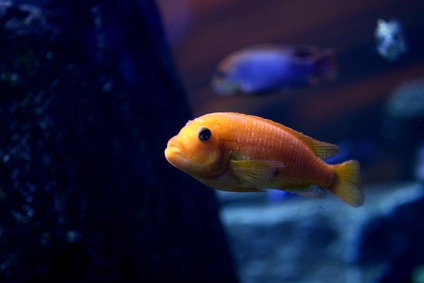
Scientific Name: Puntius tetrazona
Breeding Method: Plant spawner
Ease of Breeding: Easy
Introduction: Tiger barbs are popular aquarium fish because of their striking appear¬ance. While the most common variety has the black and gold stripes for which they are named, there are a number of other color varieties available, including green, albino, and blushing tiger barbs. These barbs can be nippy, a problem usually alleviated by keeping them in large groups.
Sex Differences: Males are more brightly colored, and the red on their dorsal fins is more intense; in breeding condition, they also develop a red nose. Females tend to be bigger and wider and their noses remain yellowish during spawning.
Water Conditions: Tiger barbs tolerate a wide range of water conditions, but spawn most readily in soft water with a pH of around 6.5 and the temperature set at about 77°F.
Equipment: Breeding tank should be at least 20 gallons, with a spawning grate or double layer of marbles on the bottom to catch and protect the eggs. Add a mature sponge filter, heater, and plants (artificial plants are okay) or spawning mops.
Conditioning and Triggers: Condition separately on brine shrimp and other live or frozen foods for a week or two before spawning. Sometimes, doing a water change and lowering the depth of the water will trigger a reluctant pair to spawn, as will increasing the temperature a degree or two.
Spawning: Condition the female in the breeding tank or place her in it at least two days before the male. Add the male in the afternoon. The two will soon begin swimming around one another, and the male will display by spreading his fins and hovering head down in the water. Spawning usually takes place the next morning, with the male chas¬ing the female around the tank, nipping at her fins. As they brush up against the plants, she will release several eggs at a time, and the male will fertilize them. The eggs will then drift into the plants and into the crevices between the marbles on the tank bottom. When the female has released all her eggs, the pair will lose interest in one another and should be removed from the tank.
Brood Size: Up to 700.
Fry Care: The eggs will hatch in about two days, and the fry—resembling slivers of glass with eyes—will cling to plants and the sides of the tank. Now is the time to begin culturing infusoria and baby brine shrimp, so when they become free swimming and ready to eat (something that will take about five days), you will be prepared. Feed fry about three times a day, but monitor water quality carefully to make sure it is not being polluted by leftover food. When fry grow larger, you can feed them crushed flakes and daphnia about three times a day. Proper feeding and nutrition is essential.
Species with Similar Breeding Habits: Rosy barb (Puntius conchonius); black ruby barb (P. nigrofasciatus); checkered barb (P. oligolepis).
 List of Aggressive Tropical Freshwater Fish
List of Aggressive Tropical Freshwater Fish
List of Aggressive Tropical Freshwater Fish
List of Aggressive Tropical Freshwater Fish
 Facets To Consider When Choosing A Cruise Rental
Sbiten is made at different ways, together non-alcoholic a
Facets To Consider When Choosing A Cruise Rental
Sbiten is made at different ways, together non-alcoholic a
 How to Take Care of a Baby Parrot Fish
How to Take Care of a Baby Parrot Fish
How to Take Care of a Baby Parrot Fish
How to Take Care of a Baby Parrot Fish
 Clown Fish Small Tank Set Up for Beginners
Clown Fish Small Tank Set Up for Beginners
Clown Fish Small Tank Set Up for Beginners
Clown Fish Small Tank Set Up for Beginners
 How to Take Care of a Puffer Fish
How to Take Care of a Puffer Fish
How
How to Take Care of a Puffer Fish
How to Take Care of a Puffer Fish
How
Copyright © 2005-2016 Pet Information All Rights Reserved
Contact us: www162date@outlook.com